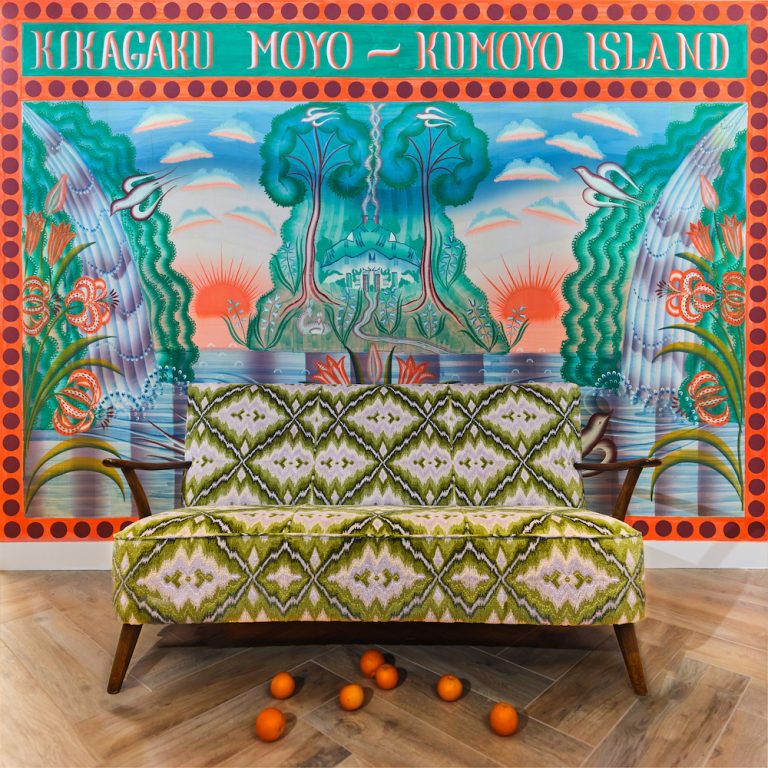When a band is reliable enough, it’s all too easy to take them for granted. Not the music itself, which fans surely treasure, but the thought that they might leave us? It just doesn’t occur to many, especially when a band appears as well-oiled and tight as Kikagaku Moyo. So, it was all the more saddening for fans when they announced their intentions to go on an indefinite hiatus, without any present intentions of reforming, following an extensive farewell tour.
Thankfully, they had one more trick – or should we say gift – up their sleeves. They had secretly recorded their fifth, and presumably last, album. As if spurred on by the finality of it all, Komoyo Island all but leaps out at you. It’s a gripping, insistent, and beyond fulfilling affair. It’s the widest the band have opened the doors into their delectably bizarre inner world to date.
One should certainly never a judge a book (erm, album) by its cover, but the artwork for Komoyo Island sets the stage immediately: in the background is the folky Japanese, yet psychedelic surreal art of the sort that graced their last LP, but in the foreground is a far more grounded image: that of an welcoming couch and fruit strewn about, waiting to be consumed. They’re inviting the listener to settle in, to nestle in their sound as a welcome guest, rather than just as a distant onlooker.
The music is likely their most inviting to date, as well. They’ve retained every bit of their psychedelic tilt, but any rough edges have been finely tuned into pure bliss, all serenity amidst their search for the perfect moment. In its ambition and scope it can even be a tad proggy, though without any of the more ostentatious trappings often associated with the genre, instead calling to mind the likes of Chile’s Los Jaivas.
Komoyo Island opens with the slow burn build up of “Monaka”, tricking the listener into thinking something jagged may be in store, all before the band plunge into a delightful groove, complete with Japanese strings and vocals that veritably seem to dance before you. This leads to “Dancing Blue”, which has a revolving nature, thanks to a cleverly circular guitar line and chattering percussion.
Following instrumental track “Effe” feels like something of a theme song for their fictional Kumoyo Island, encouraging you into their take on a Plastic Beach. “Meu Mar” reaches across cultures, borrowing from Brazilian great Erasmo Carlos, his lyrics translated to Japanese, transplanted into a lulling, delightful groove of the sort only Kikagaku Moyo could dream up, all while feeling distinctly driven by the sound of the nation from which they were clearly so inspired. Gradually a meaty riff enters the picture, stirring the otherwise gentle waters of the track, creating some enticing dissonance. It’s the perfect entrance into the dense world of what’s to come.
“Cardboard Pile” begins as if it’s already been ongoing for several minutes, a rough and tumble jam, all before subverting that notion entirely in favor of a far smoother concoction, a swirling instrumental that pulls the listener along, hurling deftly forward. In general, the album features a sense of propulsion, yet one that’s hardly detectable: you hardly notice you’re moving, like some magic trick, a revolving platform tricking you into thinking you’re still seeing the same thing, all while you’ve drifted towards another visage altogether.
“Daydream Soda”, driven by native percussion and the occasional distant vocal, captures this notion as well; it sparkles with energy. “Yayoi, Iyayoi”, meanwhile, is beset by emotion, as if the band themselves are feeling the finality of their journey here, all before engaging with a rousing riff, crafting a song that’s between sorrow and cocksure joy, gradually giving way to a playful, chant-laden jam. “Nap Song”, for its part, sounds exactly like its title implies, a gentle cushion just as we prepare to (deep sigh) leave the world of Kigagaku Moyo forever.
Before they leave us, however, we’re left with “Maison Silk Road”, which opens with an extended, gentle backdrop, nearly ambient in its inspiration, with distant chatter that seems to embody the feeling of waiting for a train in some distant, unknowable locale. Gradually, gentle guitar and piano keys enter the picture, providing a wistful, bleary eyed departure. It feels akin to waking up, still groggy, and taking in the world before you. It’s surely a different world, now, with them gone. They’ve left us with all they had to offer.

